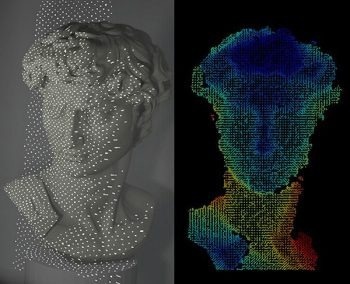Many people are familiar with facial recognition software that may be used to access online bank accounts, unlock devices, and play games. However, the projectors and lenses used by the current technology can be bulky.

A new lens-free and compact system for facial recognition scans a bust of Michelangelo’s David and reconstructs the image using less power than existing 3D surface imaging systems. Image Credit: The American Chemical Society (ACS)
A more streamlined 3D surface imaging system with flatter, simpler optics has now been reported by researchers in ACS's Nano Letters. In proof-of-concept tests, the new system was able to identify Michelangelo's David's face with the same accuracy as an existing smartphone system.
In computer vision, autonomous driving, and facial recognition on smartphones, 3D surface image is a popular technology. A dot projector with a laser, lenses, a light guide, and a diffractive optical element (DOE) is usually the main component of these systems. A unique type of lens called a DOE divides the laser beam into an array of roughly 32,000 infrared dots.
To verify an individual's identification, facial recognition technology projects a pattern of dots across the majority of their face when they stare at a locked screen. The device's camera then interprets this pattern. Dot projector systems, however, are too bulky for tiny gadgets like cell phones.
Thus, Yu-Heng Hong, Hao-Chung Kuo, Yao-Wei Huang, and associates set out to create a more energy-efficient and compact face recognition system that would be almost flat.
The imaging device's size and power consumption were greatly reduced by the researchers by substituting a low-power laser and a flat gallium arsenide surface for the conventional dot projector. They created a metasurface that scatters light as it travels through the material by etching a nanopillar pattern on the top of this thin metallic surface.
This prototype uses low-power laser light scattering to project 45,700 infrared dots onto a face or object in front of the light source. Similar to the dot projector method, the new setup uses a camera to interpret the patterns produced by the infrared dots.
During prototype testing, the system successfully recognized a 3D copy of Michelangelo's David by comparing its infrared dot patterns to images of the well-known statue that was found online. Notably, it accomplished this using five to 10 times less power and on a platform with a surface area around 230 times less than a standard dot-projector system.
According to the researchers, their prototype shows how metasurfaces can be used to provide efficient small-scale, low-power imaging solutions for robotics, augmented reality, and face recognition.
The research was funded by Hon Hai Precision Industry, the National Science and Technology Council in Taiwan, and the Ministry of Education in Taiwan.
Journal Reference
Hsu, W.-C., et.al. (2024). Metasurface- and PCSEL-Based Structured Light for Monocular Depth Perception and Facial Recognition. Nano Letters. https://doi.org/10.1021/acs.nanolett.3c05002